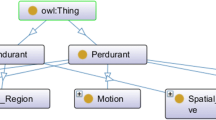Abstract
In an experimental setting of mechanical-object assembly, the CODY (“Concept Dynamics”) project is concerned with the development of knowledge representations and inference methods that are able to dynamically conceptualize the situation in the task environment. A central aim is to enable an artificial agent to understand and process natural-language instructions of a human partner. Instructions may build on the current perception of the assembly environment on the one hand, and on the other on the knowledge-based understanding of grouped structures in the developing construct. To this end, a dynamic conceptualization must integrate information not only describing the types of the objects involved, but also their changing functional roles when becoming part of structured assemblies.
We have developed an operational knowledge representation formalism, COAR (“Concepts for Objects, Assemblies, and Roles”), by which processes of dynamic conceptualization in sequences of assembly steps can be formally reconstructed. Inferences concern the assertion or retraction of aggregate representations in a dynamic knowledge base, as well as the computation of role changes for individual objects associated herewith. The structural representations integrate situated spatial features and relations, such as position, size, distance, or orthogonality, which are inferred on need from a geometry description of the task environment. The capacity of our approach has been evaluated in a 3D computergraphics simulation environment.
1 A running demonstration of the virtual assembly workbench can be seen in our contribution to the IJCAI-95 Videotape Program, cf. (Cao et al., 1995).
2 Some readers may still want to refer to this “false” propeller as a propeller. This is not the point in our current work. Our point is to provide means for recognizing a propeller that is correctly built according to its definition. Should the right-hand-side assemblage in Fig. 4 be recognizable as a propeller, we could allow for an according “slack” in the routine which evaluates orthogonality. Yet another point is how reference could be established to the right-hand-side assemblage by a description like “the propeller on the right”. This topic concerns future work.
Similar content being viewed by others
References
Y. Cao, B. Jung, and I. Wachsmuth: 1995. Situated verbal interaction in virtual design and assembly, IJCAI-95 Videotape Program. Abstract in Proc. 14 th International Joint Conference on Artificial Intelligence, Morgan Kaufman, pages 2061–2062.
G.A. Fink, F. Kummert, and G. Sagerer: 1994. A close high-level interaction scheme for recognition and interpretation of speech. In International Conference on Spoken Language Processing, volume 4, Yokohama, Japan, pages 2183–2186.
Thomas Fuhr, Gudrun Socher, Christian Scheering, and Gerhard Sagerer: 1995. A three-dimensional spatial model for the interpretation of image data. In IJCAI-95 Workshop on Representation and Processing of Spatial Expressions, 14th Int. Joint Conf. on Art. Int. (IJCAI-95), Montréal, Canada, pages 93–102.
M.Genesereth and N.Nilsson: 1987. Logical Foundations of Artificial Intelligence. Morgan Kaufmann, Los Altos, CA.
Th.Gruber and G.Olsen: 1994. An ontology for engineering mathematics. In Principles of Knowledge Representation and Reasoning. Morgan Kaufmann, San Francisco, CA, pages 258–269.
N.Guarino, M.Carrara, and P.Giaretta: 1994. An ontology of meta-level categories. In Principles of Knowledge Representation and Reasoning. Morgan Kaufmann, San Francisco, CA, pages 270–280.
B. Jung, B. Lenzmann, and I. Wachsmuth: 1995. Interaktive Montage-Simulation mit wissensbasierter Grafik. SFB 360 Report 95/6, Universität Bielefeld.
B. Jung and I. Wachsmuth: 1994. Dynamische Konzeptualisierung. SFB 360 Report 94/9, Universität Bielefeld.
B. Jung and I. Wachsmuth: 1995. Integrating spatial and conceptual knowledge in virtual assembly. In L. Dreschler-Fischer and S. Pribbenow, editors, KI-95 Activities: Workshops, Posters, Demos. GI, pages 103–104.
R. Moratz, H.J. Eikmeyer, B. Hildebrandt, F. Kummert, G. Rickheit, and G. Sagerer: 1995. Integrating speech and selective visual perception using a semantic network. In 1995 AAAI Fall Symposium on Computational Models for Integrating Language and Vision, Cambridge, MA, (to appear).
H.Niemann, G.Sagerer, S.Schröder, and F.Kummert: 1990. ERNEST: A semantic network for pattern understanding: IEEE Transactions on Pattern Analysis, 12(9), pages 883–903.
L.Padgham and P.Lambrix: 1994. A framework for part-of hierarchies in terminological logics. In Principles of Knowledge Representation and Reasoning. Morgan Kaufmann, San Francisco, CA, pages 485–496.
G.Rickheit and H.Strohner: 1994. Kognitive Grundlagen situierter künstlicher Kommunikatoren. In H.-J.Kornadt, J.Grabowski, and R.Mangold-Allwin, editors, Sprache und Kognition: Perspektiven moderner Sprachpsychologie. Spektrum Akademischer Verlag, Heidelberg, pages 73–92.
G. Rickheit and I. Wachsmuth: 1996. Collaborative Research Centre “Situated Artificial Communicators” at the University of Bielefeld. This volume 10(3–4).
G.Sagerer: 1990. Automatisches Verstehen gesprochener Sprache. Bibliographisches Institut, Mannheim.
J.Sowa: 1988. Using a lexicon of canonical graphs in a semantic interpreter. In M. W.Evens, editor, Relational Models of the Lexicon. Cambridge University Press, Cambridge, UK, pages 112–137.
E. C.Way: 1991. Knowledge Representation and Metaphor. Kluwer, Dordrecht.
Author information
Authors and Affiliations
Rights and permissions
About this article
Cite this article
Wachsmuth, I., Jung, B. Dynamic conceptualization in a mechanical-object assembly environment. Artif Intell Rev 10, 345–368 (1996). https://doi.org/10.1007/BF00127686
Issue Date:
DOI: https://doi.org/10.1007/BF00127686




